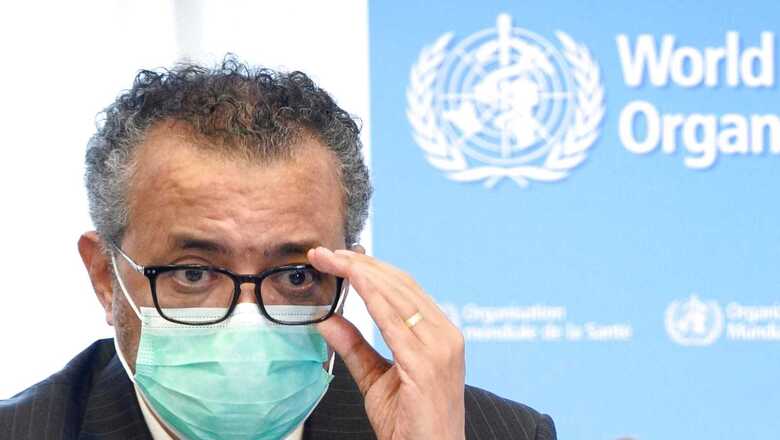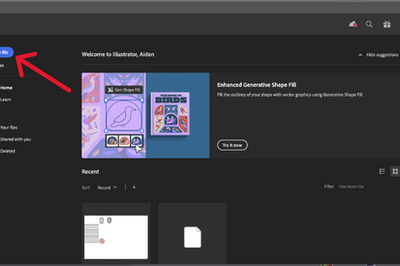
views
December 31 does not only mark the end of the year, but the date is important in the short history of Covid-19. On this date in 2019, health authorities in China’s Wuhan informed about cases of an “unknown pneumonia outbreak” to World Health Oganization’s China Country Office in Beijing.
The press note issued by the WHO on January 5, 2020, read: “Clinical signs and symptoms are mainly fever with a few patients having difficulty in breathing, and chest radiographs showing invasive lesions of both lungs.”
In its risk assessment, the WHO further noted, “The reported link to a wholesale fish and live animal market could indicate an exposure link to animals.” The international agency hinted at the possibility of SARS-CoV-2 jumping the species barrier from animal to human.
Two years have passed, infections world over have crossed 286 million and counting, with over 5.4 million deaths and trillions of dollars in economic losses. Yet, there is no clarity on how the novel coronavirus emerged and how it jumped onto humans bringing to fore an unprecedented global health crisis.
In the dock are WHO and its chief Dr Tedros Adhanom Ghebreyesus as well as China.
There is absolutely no doubt that the first clusters of Covid-19 cases were found in Wuhan as early as the first week of December 2019. By December 31, 2019, the novel coronavirus was eventually identified. But it took WHO the next 70 days to declare the Covid-19 outbreak a pandemic on March 11, 2020.
In between, the number of patients, which was limited to 44 and localised in Wuhan, rose to around 1.14 lakh, spread across 114 nations and over 4,000 deaths. The world lost precious time as the deadly virus silently sped across the globe.
The global health body, many experts argue, not just provided conflicting and confusing guidance but allegedly did everything to cover Chinese tracks.
On January 14, 2020, WHO tweeted that preliminary investigations by Chinese authorities found “no clear evidence of human-to-human transmission”. The global health body’s faith and further transmission of Chinese words provided a false sense of security to the world.
The WHO defended delays in raising a global alarm saying it has to rely on member countries to truthfully report their findings. “WHO is open. We don’t hide anything,” said Dr Ghebreyesus.
Later, it came to light that Taiwan’s Centers for Disease Control (Taiwan CDC) had on December 31, 2019, already sent an email to WHO warning about “a real possibility of human-to-human transmission of the disease”. Dr Ghebreyesus denied this, saying, “Taiwan didn’t report any human-to-human transmission.”
In January, in an interview to Qatari broadcaster Al Jazeera, Taiwan’s ex-health minister Chen Chien-jen said: “If the situation in Wuhan was very well reported to the World Health Organization and it organised a team and went to Wuhan in mid-December 2019, I think the disease could have been contained and no other countries would have suffered.”
But the WHO chief was too trusting of Beijing. On January 28, 2020, after meeting Chinese President Xi Jinping in Beijing, Dr Ghebreyesus heaped praise on Chinese leadership. “We appreciate the seriousness with which China is taking this outbreak, especially the commitment from top leadership and the transparency they have demonstrated, including sharing data and genetic sequence of the virus,” he had said.
China, meanwhile, was busy censuring critical pieces of information and arresting those who were speaking the truth about the virus spread.
“Authorities initially covered up news about the virus, then adopted harsh quarantine measures in Wuhan and other parts of China,” said Human Rights Watch in its 2021 report, accusing Chinese authorities of surveillance and harassing families of those who died of the virus.
Evidence of Chinese wrongdoings were at hand and, yet, Dr Ghebreyesus looked the other way and did not push it on its early blunders.
The WHO chief’s applause for China at the Munich Security Conference in February 15, 2020, attracted sharp criticism. WHO chief said steps taken by China to “contain the outbreak at its source appear to have bought the world time, even though those steps have come at a greater cost to China itself”.
Not stopping with just unrestrained praise for Beijing, the WHO chief also castigated other countries for their responses to the outbreak. At the WHO’s executive board meeting last year, Dr Ghebreyesus urged countries not to limit travel to China and warned against politicisation of the outbreak. The world was in darkness, and the response to Covid-19 was being delayed.
But the WHO chief’s effusive praise cut no ice with Beijing when the global health body needed unrestricted and unfettered access inside Wuhan, the first place to report viral pneumonia, “to identify the zoonotic source”.
In May 2020, the World Health Assembly passed a resolution citing a need for an independent probe to find Covid-19 origins. But it took WHO’s time, effort and multiple rounds of negotiations before Beijing agreed.
In January, WHO scientists were back in Wuhan. The four-week joint study with Chinese counterparts was severely constrained. The Chinese decided over who will be part of the probe, refused to share raw data on early Covid-19 cases. The team was not allowed access to probe different hypotheses around how the virus jumped into humans.
Later, on March 30, Dr Ghebreyesus, while briefing member states on the report of the probe team, said China withheld important data from investigators. “In my discussions with the team, they expressed the difficulties they encountered in accessing raw data,” he said, adding, “I expect future collaborative studies to include more timely and comprehensive data sharing.”
The WHO probe team’s end report, running into thousands of pages, remained inconclusive as the lab leak theory was termed “extremely unlikely” but with Dr Ghebreyesus adding that “this requires further investigation, potentially with additional missions involving specialist experts”. The report could not say anything conclusive on the role of Wuhan animal markets.
Later, Peter Ben Embarek, the WHO expert who led the Wuhan probe, told a Danish television documentary that China pressured his team to dismiss the lab leak theory.
In August, China rejected WHO’s demand for a renewed probe saying such calls were motivated by politics instead of scientific inquiry. Moreover, Chinese authorities are engaged in disinformation campaign which, according to an investigation by the Associated Press, includes “promoting fringe theories that the virus could have come from outside the country”.
Recently, the Chinese official Xinhua news agency and state-run Global Times published a research report titled ‘US responsible for global spread of Covid-19’ blaming the US as the “most likely country where Covid-19 originated, and the country most responsible for the fast global spread of the virus”.
Two years have passed since the Covid-19 pandemic struck the world, yet we are still to find its origins. There are many hypotheses but no clear answer as to how the pandemic began and how the virus made its way to humans.
The SARS-CoV-2 virus is evolving faster and nailing it can take years. If by any chance, however, human endeavour succeeds in tracing its evolutionary path, it would become much easier for them to prevent future viral spillovers.
Read all the Latest Opinions here



















Comments
0 comment